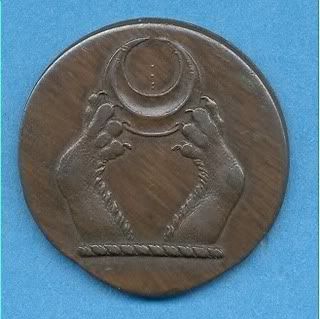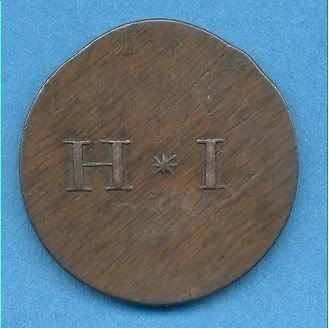ID help, please? Maybe a conder...
Hi, all ~
Picked up this farthing-size token from a British seller who says it's been
kept in a collection of Conders for ages, so he estimates 1790's. Neither
he nor I have a clue what it is, really.
Any ideas from The Forum?
Thanks in advance for any help you might be able to give me on attributing this.
Best ~
Tom
(Bill McKivor at The Copper Corner will be my next stop.)


Picked up this farthing-size token from a British seller who says it's been
kept in a collection of Conders for ages, so he estimates 1790's. Neither
he nor I have a clue what it is, really.
Any ideas from The Forum?
Thanks in advance for any help you might be able to give me on attributing this.
Best ~
Tom
(Bill McKivor at The Copper Corner will be my next stop.)


I never pay too much for my tokens...but every now and then I may buy them too soon.
Proud (but humbled) "You Suck" Designee, February 2010.
Proud (but humbled) "You Suck" Designee, February 2010.
0
Comments
Life member #369 of the Royal Canadian Numismatic Association
Member of Canadian Association of Token Collectors
Collector of:
Canadian coins and pre-confederation tokens
Darkside proof/mint sets dated 1960
My Ebay
Collecting:
Conder tokens
19th & 20th Century coins from Great Britain and the Realm
http://tjbuggey.ancients.info/astro.html
The site is: http://cheshire-heraldry.org.uk/visitations/CV15.html
One of the things it talks about is the Crescent with horned ends... here is an exert.
Marks of Cadency for a Coat Of Arms
First through the Sixth
Just as the original intent of a Coat of Arms was to distinguish one knight from another (since they were in armor with a helm protecting and also hiding their features), it was also necessary to provide distinctive bearings for different members of a family all entitled to bear the paternal arms. This gave rise to the use of Marks of Cadency, or differences (called by the French brisure.)
The eldest son (during the lifetime of his father) bears a label of three points; the second son, a crescent; the third, a mullet; the fourth, a martlet; the fifth, an annulet; the sixth, a fleur-de-lis.Some historical documentation carries that out to the tenth with the seventh bearing a rose, the eighth a cross moline, the ninth an anchor, and the tenth a double quatrefoil.
The graphics below shows each of the Marks of Cadency and then below that is a group of examples displaying how the original Coat of Arms might look along with each of the Marks of Cadency then being displayed as well.
Crescent
The crescent stands for one who has been "enlightened and honored by the gracious aspect of his sovereign." It is also borne as a symbol of the hope of greater glory. Crescents also represent the moon that lights the night sky for travelers, though it does not resemble the shape of a crescent moon very closely. In English arms it was also a mark of cadency signifying the second son
Hurley of Sidwall looks like a prime suspect to me!
Thanks, guys...I'll let you know what else I can dig up.
Best ~
Tom
Proud (but humbled) "You Suck" Designee, February 2010.
http://cheshire-heraldry.org.uk/visitations/CV21.html
Minshull of Minshull and Minshull of Yardeswike
Arms: Quarterly -
1 & 4 Azure, an estoile of six points issuing from a crescent Argent.
2 & 3 Sable, three bucks' heads cabossed Argent [Berington]
Crest: Two lions' gambs couped and erect Gules supporting a crescent.
Look at the top of the coat or arms... two paws holding the crescent/horn...
How do you do it? I mean, how do you even know where to look,
or where to search and what terms to use?
I've obviously got some research skills to learn!
Thanks so much...you've definitely steered me in the right direction.
I did hear from Bill McKivor last night, and he wrote:
"This piece is one I have seen a few times, and even owned one. No one is sure just what it is,
but guesses have ranged from a boundary token to a colliery token. It is 18th century.
As very few boundary pieces are this small [farthing size], I am guessing a Colliery piece,
the obverse a symbol of, perhaps, the family, and the reverse the family initials
I too found it interesting, but still have no clue as to what it represented."
Happy St. Patrick's Day to all!
(I'm half-Henesy.)
Best ~
Tom
P.S. Here are a few shamrocks to celebrate...
Proud (but humbled) "You Suck" Designee, February 2010.
Cathy
these things, or some other closely related exonumia, would have a clue.
So, a couple of quick takes here:
A colliery is essentially a coal mine, but back in 18th-century England the term was probably used to include
the distribution end of the business as well; that is to say, office headquarters, the merchants or brokers
who sold the coal to the homeowner or factory, the folks and their horses who trucked the stuff around, etc.
A "collier" was the label for someone who worked in almost any aspect of the coal business...including
owners and miners alike, I think..
The boundary token was a one-shot medal or medallion issued to commemorate the day on which the town fathers or church
elders would lead a parade or procession around the perimeter of the village or parish to re-establish, ina figurative or
symbolic sense, their dominion over the territory thus circumscribed. These were rare and infrequent events, so the tokens
themselves are seldom seen. Gateshead Parish issued one in 1824 that is doubtless the most frequently encountered and
that generally changes hands these days for a few hundred bucks. (Again, quite infrequently.)
It dawns on me that there's a modern equivalent to this, one that I've actually encountered. If a college or university
campus allows regular civilian traffic to use a campus road as a thoroughfare, the road may have to be closed
to the public one day a year for the college to assert its private ownership and maintain its tax-free status...sort of
to prevent the city from claiming the road as public property. No tokens invloved, though.
Best to all ~
Tom
Proud (but humbled) "You Suck" Designee, February 2010.